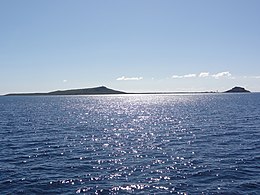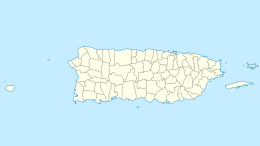Caja de Muertos, Puerto Rico

Isla Caja de Muertos, Ponce Puerto Rico, looking Southeast from Puerto Rico's mainland southern shore
|
|
|
Caja de Muertos, Puerto Rico
|
|
| Geography | |
|---|---|
| Location | Ponce, Puerto Rico |
| Coordinates | 17°53′41″N 66°31′8″W / 17.89472°N 66.51889°W |
| Area | 1.54 km2 (0.59 sq mi) |
| Length | 2.75 km (1.709 mi) |
| Width | 0.86 km (0.534 mi) |
| Highest elevation | 52 m (171 ft) |
| Administration | |
|
United States
|
|
| Commonwealth | Puerto Rico |
| Municipality | Ponce |
| Demographics | |
| Population | 0 |
| Pop. density | 0 /km2 (0 /sq mi) |
Coordinates: 17°53′41″N 66°31′8″W / 17.89472°N 66.51889°W
Caja de Muertos (English: Coffin Island or Dead Man's Chest) is an uninhabited island off the southern coast of Puerto Rico, in the municipality of Ponce. The island is protected by the Reserva Natural Caja de Muertos natural reserve, because of its native turtle traffic. Hikers and beachgoers are often seen in the island, which can be reached by ferry from the La Guancha Boardwalk sector of Ponce Playa. Together with Cardona, Ratones, Morrillito, Isla del Frio, Gatas, and Isla de Jueyes, Caja de Muertos is one of seven islands ascribed to the municipality of Ponce.
In 1599, several English merchants departed to China with a letter from Queen Elizabeth to the Chinese government. However, the expedition was dangerous and a ship was lost to the weather. Off the Indian coast the group turned to piracy and after learning of a Portuguese ship filled with gold, silver, precious stones, other treasures and other valuables (spices, silk, some clothing), they attacked and captured the vessel. The fleet managed to capture another vessel, but in the process lost its flagship and a large part of the crew was fatally injured, including the fleet commander. Shorthanded, the group decided to return to England aboard a smaller ship, taking part of the loot with them. After surviving an attempted mutiny, the Englishmen decided to take a canoe left behind by a frigate off Puerto Rico's eastern coast from where they took refuge at Caja de Muertos. Losing the smaller vessel, the Englishmen traveled to the main island in search of provisions, but one of them left behind to mind the canoe was captured and let the presence of the treasure known to the local authorities.
...
Wikipedia

